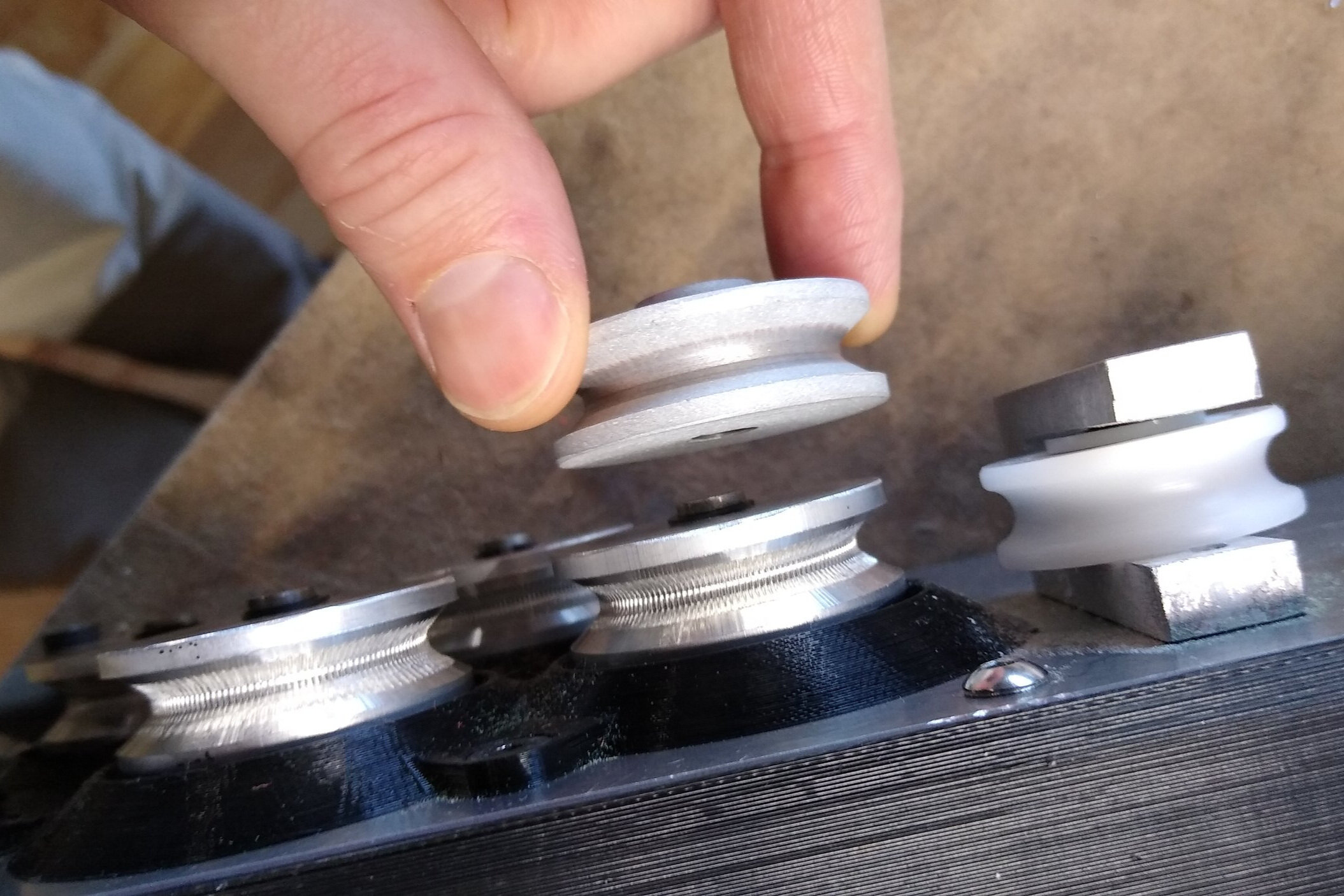In recent days we’ve been doing a lot of field testing and bench testing.
TLDR:
We’ve switched from a urethane pulley to a solid aluminum pulley with promising results so far.
Paracord is still a preferred option for affordability, weight, and packability, but other ropes, especially static ones, may be more reliable in more varied conditions.
The new pulley design may open up additional options for ropes that couldn’t be gripped effectively by the urethane pulleys. Solid braid nylon won’t be recommended for use with the device.
A new motor enclosure seems to have resolved the overheating issue.
We are ready to start screening beta customers, but it will take some time before the betas can be built.
Pulleys
Up until recently, we have been iterating on various urethane pulleys. While it isn’t difficult to make them grip well, we have found it very difficult to have them grip without wearing out quickly. In response, we’ve moved to a solid aluminum pulley. I was skeptical that we could have an aluminum pulley grip the rope without also damaging it, but my intuition was proven wrong.
With some “creative” machining I was able to add a bit of a knurl to the inside of the pulleys. So far this has worked pretty well. After positive bench test results, I had two days of field testing with the first iteration of the design. I have posted footage from the first day and the second and they are embedded on the web version of this update. After the rope failure you can see in the second video, I improved my machining process and made a new set of pulleys with a coarser and deeper texture which has further improved the grip and opened up some new options for ropes.
We don’t have any data yet, but it’s worth noting that while I’ve been experimenting with finishes I can machine myself, I have also sent out samples to an outside company to try some much more advanced finishes meant to enhance grip.
Ropes
As you can see in the videos, we are continuing to experiment with various types of rope.
We are still using paracord as the benchmark for device performance. It is lightweight, affordable, and packs extremely well. On the downside, it stretches a lot and it compresses enough that it is more difficult to grip than some of the ropes we’ve been testing.
Both videos show different types of static 4mm accessory cords, which have gripped and performed well so far. The lack of stretch results in instant acceleration and less variation in speed as slopes change. It also makes it easier to stop or slow down part way up an ascent, as the rope doesn’t spring back as much when tension is relieved. While they share a nominal diameter, these ropes are significantly bulkier than paracord.
In my most recent field testing (sorry no video right now), I tested the coarser pulley design with a UHMWPE rope and a solid braid nylon. The UHMWPE rope is a hollow braid design and it is very slick. In previous testing with the urethane pulleys I was not able to grip it effectively. With the latest design I had positive results during bench tests, and had no problems on my first ascent in the field. On my second ascent I had issues gripping the rope. I have a few theories on what happened and how I might be able to address the issue, but haven’t confirmed those yet. Even if this particular UHMWPE rope won’t work, the initial test results show that other synthetic ropes that I had previously dismissed as too slick could work out.
The solid braid nylon failed on my first run with it during my last test. The failure looked similar to the failure with the paracord in the second video and happened around the same spot, but in this case, I don’t think the pulleys slipping was the primary failure mechanic. The solid braid nylon has the lowest breaking strength of all the ropes I have tested with, and it looks like it mostly failed in tension. This matches results we’ve seen in bench tests. Based on this and previous failures in the field, we can confidently cross solid braid nylon off the list of ropes to use with the PL1.
Heat
I brought up an overheating issue in the last update. With the latest version of the motor enclosure we seem to have resolved that. There is much more ventilation in the new design, and it will take further testing to ensure that water/snow ingress won’t be an issue.
Beta Testing
There’s still more testing that needs to be done with the alpha prototypes, but during this time we’re trying to prepare for the next phase of development. We intend to launch a limited paid beta trial before launching the product.
Our production capacity is very limited, so we are going to be selective about who can participate. We want to prioritize folks who have reached out to us early, but also need to consider a number of other factors. Customers living in Canada, especially in BC, are the easiest for us to work with logistically. We are open to working with international customers if there’s a good case for it. Other important factors include the expected frequency of use, the typical use scenario, and the customer’s experience and expertise. Customers that wish to participate will need to agree to the terms of the trial and sale.
If you are interested in being a beta tester, please reach out to me at rbutton@zoaeng.com and put “Beta Application” as the subject. Be sure to address all the criteria mentioned in the previous paragraph.
If you have already e-mailed me expressing your interest in being a beta tester, this has been noted and you do not need to e-mail me again to be considered.



